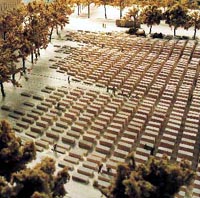November 2003
Underground Networks
 On the power of posters, pamphlets, and petitions in the time of globalization.
On the power of posters, pamphlets, and petitions in the time of globalization.
From “Sailing the Black Atlantic,” by Adam Hochschild, a review of Making the Black Atlantic. Britain and the African Diaspora, in The Times Literary Supplement, October 6, 2000:
“By requiring a complex skein of transport, trade, credit and insurance ties that connected Europe, Africa and the Americas, slavery and the slave trade were the core of the eighteenth century’s version of globalization.
In turn, one might call the black diaspora the era’s Internet. As Walvin points out, it was an information network. Word of the dramatic blossoming of abolitionism in England, for instance, was eagerly carried back across the Atlantic by black sailors, and by black domestics brought back and forth across the ocean by their West Indian masters. Slaves waiting on plantation dinner tables in Jamaica or Barbados listened hard when their owners cursed the do-gooders in Parliament, or the Quakers, who organized a huge boycott of slave-grown sugar. News from each side of the Atlantic affected the other. Reports of hundreds of abolitionist petitions flooding Parliament helped spark some of the revolts among impatient slaves in the Caribbean. The first major uprising, in the French colony of Saint Domingue (later Haiti) in the 1790s, provoked a backlash in Britain against the abolitionists, but a later one, in Jamaica in 1831-2, was crucial in hastening emancipation.”
Toll
Reading the catalog for Me, Myself, and Infrastructure, I stumble onto this:
“The corporations with the highest revenues in the U.S. are Wal-Mart, Exxon Mobil, General Motors, and Ford. They base their business on the supremacy of the road in American life.”
Wow! Incredulous, I consult Google. It’s true. Sometimes, living blissfully without a car in New York City, one forgets how the rest of this enormous country lives.
But then, via Planetizen my revelation is adjusted again. Sprawl is not propelled simply by consumer demand, but by lobbyists and politics that protect and promote the interests of those same companies.
Branding Peace
![]() A publisher of graphic design books in Barcelona will soon produce a book compiling a selection posters against the war in Iraq designed by artists around the world. When soliciting submissions, the editor announced that profits from the book would be donated to Amnesty International.
A publisher of graphic design books in Barcelona will soon produce a book compiling a selection posters against the war in Iraq designed by artists around the world. When soliciting submissions, the editor announced that profits from the book would be donated to Amnesty International.
I informed the editor that it was a little strange for a book of anti-war posters to support an organization that never actually opposed the war. He was shocked to hear this.
He quoted from Amnesty’s Web site:
“In February 2003, before the start of the war, Amnesty International handed to the UN a petition signed by more than 60,000 people in nearly 200 countries and territories calling on the Security Council to assess the human rights and humanitarian impact on the civilian population of any military action against Iraq.”
This is true, but this is not the same as opposing the war. In fact, this actually implies that the invasion is just fine as long as the humanitarian and human rights impact is within some acceptable limit. This is consistent with International Humanitarian Law. Under IHL, a certain amount of “collateral damage” is assumed. You can kill plenty of civilians, as long as you are not specifically targeting them and have taken some measures to minimize harm.
Amnesty does wonderful work on behalf of prisoners around the world, but they are not an anti-war organization. They are not actually opposed to war, but war crimes. Contradictions abound: Amnesty opposes the use of land-mines as “inhumane,” but takes no position on nuclear weapons. Amnesty also recently launched a campaign to control the trafficking of small arms, though they say nothing about the general trade of large weapons.
The editor wrote, “I went through a list of charity organizations and Amnesty is one that gets one of the highest marks for how much money they use from donations for actual causes rather than promotion etc. Also, they were only one of many charities who responded to my query.”
I pointed out that Amnesty’s is not structured like other organizations. Amnesty’s London office does all the research and generates materials for advocacy, but does no fundraising or marketing at all. It is Amnesty’s autonomous national offices that do the fundraising and marketing. The national offices send a portion of their funds back to the international headquarters in London. Thus, if you looked at the international headquarters of Amnesty it would appear that they spent all of their money on program work and none on fundraising. This is true, but misleading.
I also noted that Amnesty is a well-funded organization. The budget of the its international headquarters was £23,728,000 in fiscal year 2002. That headquarters employs 410 staff. In contrast, many of the small organizations and coalitions that came together specifically to oppose the war are struggling to stay afloat and to keep the pressure on. These groups could use the money a lot more than Amnesty.
The editor considered my arguments and later circulated a poll to let the contributing artists decide who should receive the proceeds. He wrote:
“My original plan for the book was to donate a portion of the profits from the book to a non governmental organization (NGO) which could use the money to help promote peace, non-violence, and help people affected by war. There are many such organizations around the world and it has been very hard to choose one to be the recipient of this donation. I am hoping that you, the artists, can help me choose one of these NGOs and make this a truly democratic project.
The following is a list of NGOs which are internationally recognized and are currently making efforts to help the people in Iraq, either by organizing people against the occupation, or helping people on the ground.
- Amnesty International
- International Answer
- International Committee of the Red Cross
- Not in Our Name
- Oxfam
- Peace Action
- Stop the War Coalition
- United for Peace & Justice
- Win Without War
- War Resisters League
Of the organizations listed, Amnesty International is the only one that has neither opposed to the occupation nor delivered supplies and relief to the people of Iraq. Instead Amnesty asks the occupying forces themselves to ensure that provisions and medical supplies are delivered. Take a look at Amnesty’s own briefing paper on Iraq. Amnesty calls for oil revenue to benefit the people of Iraq, but does not name specific U.S. contracts and companies profiting instead. Amnesty calls for “justice and security,” but not for the transfer of power to the people of Iraq. Amnesty calls for investigations into cases of abuse by US and UK soldiers in Iraq, but would never call for Bush or his administration to be held accountable for the lies that put them there.
No matter. When the votes were tallied, Amnesty International won by landslide.
Peace People Japan
 Wouldn’t it be great if we never had any need for a military? Failing that, how about a military forever sworn off of war? Japan’s military has done this for the last 50 years. This will soon change, however, as they enter the war in Iraq.
Wouldn’t it be great if we never had any need for a military? Failing that, how about a military forever sworn off of war? Japan’s military has done this for the last 50 years. This will soon change, however, as they enter the war in Iraq.
Article 9 of the constitution of Japan states:
“The Japanese people forever renounce war as a sovereign right of the nation and the threat or use of force as a means of settling international disputes.”
This is interpreted as permitting a standing army known as the Self-Defense Forces (SDF), but has prohibited those forces from being deployed outside of Japan or possessing nuclear weapons.
Still, with nearly 240,000 military personnel and an annual budget of nearly $50 billion in 2002, Japan’s military outstrips Britain’s in total spending and manpower. [source]
In the past Article 9 prevented the SDF from participating in military conflict and limited Japanese involvement to mostly financial support.
However, just as the United States wrote that constitution, Japan is slowly amending it under U.S. pressure.
“With each global ‘crisis,’ the Japanese government has taken the opportunity to enact new legislation to circumvent Article 9 and its clear renunciation of war.
One of the larger circumventions was the Peace Keeping Operations Law of 1992 which was passed during the Gulf War. This law allowed Japan to take part, if in a limited way, in United Nations-led peacekeeping operations. Other laws that have eroded the force of the Peace Provision are the 1999 law on Japan-U.S. security cooperation in dealing with emergencies around Japan, and the 2001 anti-terrorism special measures law.
The terrorist acts of September 2001 and the subsequent pressure from the United States has provided the latest opportunity for the Japanese government to pass legislation increasing the country’s legal right to conduct war.” [source]
Following the lead of the United States, the meaning of “self-defense” has now been expanded to include “pre-emptive” attack. In February 2003, Defense Minister Shigeru Ishiba warned that Japanese military would launch a pre-emptive military action against North Korea if it had firm evidence Pyongyang was planning a missile attack. It would be “a self-defense measure.”
In July 2003, the Diet approved a plan to send 1,000 troops to Iraq. The vote turned into an outright brawl on the floor between MP’s for and against the vote. (See the pic.)
This is not the first time Japan has cleaned up after a U.S. war. Japan gave $13 billion during the first Gulf War in 1991, but did not send troops. More recently, Japan deployed an SDF demining team to Afghanistan.
 Yesterday’s New York Times reports that deployment for Iraq is scheduled for early next year.
Yesterday’s New York Times reports that deployment for Iraq is scheduled for early next year.
That July article notes that the Japanese troops will help “resettling refugees, rebuilding and providing fresh water supplies that.” The Times, also states that the Japanese will “engage in unwarlike activities,” though ominously matches the article with photos of Japanese soldiers in camouflage make-up, members of an “antitank unit” during exercises in Japan.
The Times article also notes:
“Not one Japanese soldier has been killed, or has killed, in combat since the end of World War II.
That remarkable fact is being repeated here often these days, precisely because, as Japan prepares to send ground forces to Iraq, things could change in the near future. The death of a soldier, a sad though common reality for most nations, would be a pivotal point in Japan’s postwar history.”
 The “harmlessness” of military service, a deception implied by U.S. recruiting material, is actually thus far depicted honestly in SDF materials. Here are some links to some images of SDF posters. While U.S. recruiting posters sell adventure spiced with danger and travel, the pitch here displays neither — instead mixing the adventure with uniforms, aviation, and naval technology.
The “harmlessness” of military service, a deception implied by U.S. recruiting material, is actually thus far depicted honestly in SDF materials. Here are some links to some images of SDF posters. While U.S. recruiting posters sell adventure spiced with danger and travel, the pitch here displays neither — instead mixing the adventure with uniforms, aviation, and naval technology.
The posters also seem to sell the SDF as something like a sports club, a way to impress your country, kids, and co-eds, and, recently, a distinguished career option for women. And then there’s that bizarre sci-fi poster. But then I can’t read Japanese so could be totally misinterpreting the signs.
As the Japanese military is a “Self-Defense Force,” their logo brands them as keepers of peace. The SDF are “Peace People Japan.”
The posters have been removed from the SDF site so the links above point to the Web Archive.
However, this small collection of cuddly cartoon characters is still online.
Ill Communication
In the same sitting, I stumbled into two articles on the use of cellphones to coordinate street protest in real time. One in La Paz, the other in London, the former well organized, the latter ad-hoc. One from the country, the other from the city.
From Anarchogeek:
“The use of cell phones is interesting in how it relates to transforming the rural/urban power divide within the developing world. This isn’t something entirely new, rural community radio stations have played very large roll in communication and social transformation. In Bolivia, the revolution of 1952 lead by the miners unions, was coordinated by a network of rural community radio stations. With high illiteracy, little infrastructure, very poor communities these communities have relied on radio as the primary form of mass media.
In the last decade there has been an upsurge in the political power of indigenous movements in the Andes who have their power base in rural mostly disconnected communities. A lot of that upsurge is due to the many years of organizing by indigenous leaders, social movements, and NGO’s. That said, cell phones have acted as a major amplifier of their work. Increasing the ability for people to coordinate their actions and build robust social networks.
Unfortunately, I’ve not seen much written about the use of cell phones and other communications technology in the general strike and ‘Gas War’ in Bolivia last month. From my working with the rather small group of indymedia people in Bolivia I’ve heard some of how cell phones transformed the conflict. It helped people lay a more than week-long siege to La Paz. It also helped coordinate the marches of people from other parts of the country to the capital. When women went on hunger strike in churches the communications network made it a coordinated act, not simply the act of a few brave women in one location.
I think what happened in Bolivia is quite different than the much talked about ‘smart mobs’ as there were relatively few people will cell phones. The groups were not flexible, but rather quite well organized with cell phones used to coordinate between the leadership of existing organizations and networks. The use of cell phones facilitated the biggest indigenous siege of La Paz in almost 300 years.
Other important factors was Pios Doce and other community radio stations which played a vital mass media roll during the crisis. The Pios Doce transmitter in Oruro was bombed, by people who clearly didn’t expect the police to investigate anything. What the government didn’t figure out how to do was shut off the cell phones of known organizers, or towers which serve indigenous communities. My guess is the reason they didn’t shut them down was in part because cell phones were a vital communications tool for the police and army. Even the US Army in Iraq makes extensive use of consumer walkie talkies and unencrypted Instant Messenger. In India texting has been shut off at critical points to stem the spread of rumors and coordinated race riots during communalist uprisings in the last year. I expect as social movements turn to using cell phones and related technology as a tactical tool during protests and uprisings the governments will eventually learn how to turn off the ability to communicate at will.”
This last point is also noted in the BBC article about protestors chasing Bush in London:
“Some newspapers and websites were reporting mobile phone signals could be blocked for fear they could remote-control a bomb. But Scotland Yard has denied reports that police were considering shutting mobile phone masts during protests.”
In contrast to the Bolivia protest which shut down the capitol, the UK protests are intended to be a media hack and an adjunct to the big, organized, legally-sanctioned anti-war march on Thursday.
 “The Chasing Bush campaign is asking people to ‘disrupt the PR’ of the visit by spoiling stage-managed photos.
“The Chasing Bush campaign is asking people to ‘disrupt the PR’ of the visit by spoiling stage-managed photos.
They are being encouraged to send location reports and images by mobile to be posted on the Chasing Bush site....
Technologies like text messaging and weblogs have been successfully used in the past to co-ordinate routes and meet-up points for mass protests.
But the gadgets are now being used more proactively to make protests more visible and disrupt any potential stage-managing of the President’s visit.
‘We are trying to spoil the PR, so we are not doing anything directly, but encouraging people to protest by turning their backs in press photos so they can’t be used.’
The campaign organisers have also asked people to go into protest ‘exclusion zones’ to send SMS updates and on-location reports about his appearances, and events at protests.”
See this previous post for more notes on electornic advocacy.
What Matters
From the San Francisco Chronicle, November 13, 2003:
Provocateur becomes a pragmatist
“‘We’re into Looney Tunes’ is how Eisenman described current design trends to a nearly full house at Yerba Buena Center for the Arts. ‘Ultimately, architecture is not about putting images in the New York Times, but about creating places for people to be.... Architecture has gotten more and more frenetic. It has spun out of control.’...
‘The New York Times demands these [unconventional] images because dumb, straightforward images don’t sell papers,’ Eisenman said, but he also took a bit of the blame: ‘I’m probably partly responsible. I’m not pointing fingers.’
What shifted his perspective, one senses, was the rending experience of Sept. 11, 2001. Eisenman and his family saw the second plane hit, and his son still won’t go in their building’s elevator alone. ‘He walks up 21 floors. We say, “Hey, Sam, that’s a little crazy, there won’t be an attack because you’re in an elevator,” but he feels threatened.’
 So when Eisenman says that ‘we need to rethink architecture after 9/11,’ his starting point is something more vivid than any sort of intellectual theory: He was there. And amid all the tragic losses of the terrorist attacks was a reminder that buildings, neighborhoods, cities aren’t abstractions or metaphysical conceits — they are real, and they are where people live and die.
So when Eisenman says that ‘we need to rethink architecture after 9/11,’ his starting point is something more vivid than any sort of intellectual theory: He was there. And amid all the tragic losses of the terrorist attacks was a reminder that buildings, neighborhoods, cities aren’t abstractions or metaphysical conceits — they are real, and they are where people live and die.
‘The experience of being in that place was very different than watching it [the attack] in Berlin, Tokyo, Madrid, whatever,’ Eisenman said.
Even with this shift in perception, it’s hard to imagine Eisenman leading a back-to-basics movement. He’s too dazzled by the new; later in the lecture, for instance, he enthused about how computers can record design patterns and then replicate them like a virus. Lines generated onscreen ‘can have a direction, a force, an intensity... they start to be more organic.’
And yet the lecture ended with a subtle surprise. It was Eisenman’s design for a train station near Naples, and it was a word that probably has never been associated with his work: lovely. ...
After the talk, Eisenman relaxed at a small dinner hosted by the local branch of the American Institution of Architects, one of the lecture’s sponsors. And he talked about... concrete.
Specifically, he expounded on the chore of making sure the 2,751 huge pillars at his Memorial to the Murdered Jews of Europe in Berlin have the proper look and feel. So Eisenman finds himself in Berlin at least once each month confronting workers over the quality of their mortar and mixed cement.
‘I used to say that what finally got built didn’t matter — what counted was the design as I saw it in my head,’ he said, then chuckled. ‘I can’t believe I ever thought that.’”
Designing Supportive Housing, 2
I’ve been taking a break from blogging to wrap up a few projects, but here’s a quick follow-up to a previous item from June on supportive housing:
 “Common Ground Community and The Architectural League of New York’s First Step Housing design competition ended this week with five entries sharing top honors.
“Common Ground Community and The Architectural League of New York’s First Step Housing design competition ended this week with five entries sharing top honors.
Competitors were asked to design a prototypical individualized dwelling unit and the layout of 19 such units on a typical floor of The Andrews � Common Ground’s lodging house on the Bowery - which will shortly be renovated to house the First Step Housing Program. First Step will offer private, safe, clean and affordable short-term accommodations to individuals who are transitioning to housing, facing homelessness, or who have rejected or failed in other programs.”
It’s the Architecture, Stupid!
From Turning Down the Global Thermostat by Christopher Hawthorne in the October 2003 issue of Metropolis:
“Traditionally assessments of U.S. energy consumption have been broken down into four categories: industry, which consumes about 35 percent of the total each year; transportation, 27 percent; residential, 21 percent; and commercial, 17 percent. Significantly energy consumption usually tracks pretty closely with carbon dioxide production because most of the energy consumed is in the form of fossil fuels, which release greenhouse gases — primarily carbon dioxide, methane, and nitrous oxide. Thus a pie chart showing carbon dioxide divides along roughly the same ratios as one showing energy use. ‘In every study it’s always broken down the same way,’ [Edward] Mazria says, ‘so when you look at it and ask who the bad guy is — it’s industry.’
 Mazria’s eureka moment came when he decided to redraw that pie chart with a separate slice just for architecture. He did this by combining the residential and commercial sectors, and then adding the portion of the industry sector that goes to the operation of industrial buildings and their construction. To get this last group of numbers Mazria used estimates of the so-called ‘embodied energy’ of industrial buildings. A key statistic for anybody hoping to build in a sustainable way, embodied energy is a measure of the total energy required to produce a particular material or building component and get it to a building site.
Mazria’s eureka moment came when he decided to redraw that pie chart with a separate slice just for architecture. He did this by combining the residential and commercial sectors, and then adding the portion of the industry sector that goes to the operation of industrial buildings and their construction. To get this last group of numbers Mazria used estimates of the so-called ‘embodied energy’ of industrial buildings. A key statistic for anybody hoping to build in a sustainable way, embodied energy is a measure of the total energy required to produce a particular material or building component and get it to a building site.
Mazria’s new math brought the architectural sector to a whopping 48 percent of total U.S. energy consumption. A similar rearranging of the chart for carbon dioxide production left architecture with 46 percent of the total. ‘I rounded the numbers down,’ he says. ‘I want to be careful about my numbers because people are going to attack them.’
What all of this means for Mazria is that the environmental movement has been scapegoating the wrong targets. ‘Look at SUVs,’ he says. ‘All the cars and trucks on the road account for about 6.5 percent of energy consumption in this country. If you figure SUVs as half of that, that’s 3, maybe 3.5 percent. So even if you doubled the gas mileage of every single SUV on the road, you’re talking about a marginal impact in a marginal area, all things considered. That kind of misguided focus actually keeps us from addressing the real issue.’ In other words, we’re worrying about cars when we should be worrying about buildings....
But is it fair to make architects responsible for the damage caused by the entire building industry? Mazria thinks so. He cites figures suggesting that architects design 77 percent of all nonresidential buildings, along with 70 percent of all multifamily and 25 percent of all single-family construction. And he argues that the percentage of architect-designed buildings is in fact higher than that because, as he writes, those figures ‘do not account for owner-supplied plans that were originally from architecture firms, designs by staff architects employed by building owners and developers, and single-family houses designed (but not stamped) by architects and interns.’
In Mazria’s mind, then, the architect is a perfectly legitimate new poster child for global warming: the leading part of the problem as well as, potentially, the solution. ‘Architects — and the government tends to forget this — specify every single material that goes into a building, from faucets to paint to carpet to wall materials to finishes to windows to roofing,’ he says. ‘Architects have the ability to change entire industries with the stroke of a pen. If we specify a material with low carbon dioxide emissions in its fabrication — say, floor tile, carpet, gypsum board — industry will respond. This is the American way. Architects are consumers; they’re not always aware of the incredible power they have to change the way products are manufactured.’...
He writes in his white paper: ‘We already know that buildings can be designed today to operate with less than half the energy of the average U.S. building at no additional cost. The design information needed to accomplish this is freely available.’...
The approach has also led the architect to criticize more quantitative and regulatory green initiatives, including the U.S. Green Building Council’s LEED certification program, which is currently the most expansive one in use in this country. ‘LEED-type programs can actually be damaging,’ Mazria says, ‘because they shift decisions about sustainability out of the realm of design at the workplace and put it in a separate, purely technical category. So every firm needs to get one person LEED certified, and they usually send the technical guy, not a design guy. And then that technical guy becomes the guy who has to get your design in shape for LEED, and that process becomes divorced from design.’”
See Edward Mazria’s original article from Solar Today (1MB PDF).
The Women of Juárez Demand Justice
From Daoud Sarhandi in the Autumn 2003 issue of eye magazine:
‘Femicide’ posters
“El Paso, Texas, and Ciudad Juárez, a city of 1.5m people in the northern Mexican state of Chihuahua, are less than four km apart. Yet no two cities could be economically further apart. The shantytowns spread out around Juárez are home to a vast number of indigenous migrant workers who come there from the unemployment black spots of the agrarian south. Many hope to go further, ‘la otro lado’ [to the other side], but most get stuck in the slums, working all hours, earning barely enough to survive.
Women — many as young as fourteen — comprise 70 per cent of the Juárez workforce. They eke out a four-dollar-a-day living in the maquiladoras — sweatshop factories that have mushroomed along the border since Mexico signed up to the North American Free Trade Agreement in 1992. Yet in addition to exploitation and squalor, the women of Ciudad Juárez are oppressed by a murder rate that has attracted worldwide revulsion.
 Statistics show that since 1993, at least 300 young women have been kidnapped, raped and killed — their bodies often defiled. Some 190 of these murders have occurred in the past six months; during the same period nearly 100 more have gone missing, presumed dead. The real toll may be higher, since many women do not have families living locally and their disappearances can go unnoticed and unreported. An open letter sent to the Interamerican Commission on Human Rights by angry Juárez residents puts the ‘disappeared’ figure at 450 in the past ten years.
Statistics show that since 1993, at least 300 young women have been kidnapped, raped and killed — their bodies often defiled. Some 190 of these murders have occurred in the past six months; during the same period nearly 100 more have gone missing, presumed dead. The real toll may be higher, since many women do not have families living locally and their disappearances can go unnoticed and unreported. An open letter sent to the Interamerican Commission on Human Rights by angry Juárez residents puts the ‘disappeared’ figure at 450 in the past ten years.
In the face of almost unbelievable official apathy and police incompetence, a group of graphic designers from Mexico City invited colleagues to express their concern and outrage by designing posters around the slogan ‘The Woman of Juárez Demand Justice’.
The first design activity — initially proposed by Rafael López Castro — was timed to coincide with last year’s International Day for the Elimination of Violence Against Women (25 November 2002), when protest marches against the Juárez killings took place in several towns. Nine designers produced a series of images for a support group working in Ciudad Juárez, which then distributed them to other groups dealing with domestic violence. Alejandro Magallanes and Leonel Sagahón, two designers at the centre of this project, point out that the designers gave away their images, encouraging the protest groups to apply their own text and messages.
Organised by Arnulfo Aquino and Xavier Bermúdez to mark International Women’s Day, the second event took place in March 2003. An exhibition of more than 60 large-format images by designers from all over the country was staged in a Mexico City metro station. Displays and exhibitions are often mounted in these big spaces: in a city of 20m-plus they are seen by huge numbers of people who may not often visit museums and galleries. Though Magallanes and Sagahón find several of the posters totally inappropriate, even offensive, no designs were censored from the exhibition.
López Castro notes an honest, if sometimes naíve, attempt to deal with a tough issue: the relationship between the sexuality of young, poor women, rape and murder. It has often been observed that the victims fit a series of patterns: apart from the fact that almost all come from the lower economic strata, the majority are in their teens, slim, attractive, and with long dark hair. Irresponsible local officials in Chihauhau have often blamed the girls themselves for the killings, citing the fact that they were out late and alone, or were wearing short skirts and make-up. Many designers saw these crimes — and the official reaction — as an attack on femininity itself.
López believes that the strength of this project rests in its role as a ‘collective shout’, intended to wake up the general population and the authorities. ‘It is important to see real problems,’ says Sagahón, ‘not just ‘design’ and ‘communication’ problems. We are designers, but we are also citizens, and we are also people.’
‘It was amazing,’ says Magallanes, ‘to see whole families standing in front of these posters and talking about this very difficult subject.’ One outcome of this publicity is that rather than continuing to rely on the hopelessly ad hoc investigative methods of the Chihuahua law enforcement agencies, the office of the Federal Prosecutor has now decided to investigate a number of the murders on behalf of the national government. Yet the murder phenomenon — or ‘femicide’ — shows no sign of abating. On the contrary, chillingly, it seems to be spreading to other northern Mexican towns with similar socio-economic conditions.”
The Center for the Study of Political Graphics has posted images of 60 posters online.
For more information on the violence in Juárez, see juarezwomen.com and womenontheborder.org.
Daoud Sarhandi is a co-author of Evil Doesn’t Live Here: Posters of the Bosian War.
Art, Organizing, and Memory
Ricardo Levins Morales, from an abstract of Art, Organizing, and Memory:
“The telling of history is more than an exercise in documentation. It has always been an important element in shaping history. Historical narrative provides important information about both specific tactics and strategies and broader possibilities for action. Consequently, the struggle to control the memory of events is an important element of social conflict.
 The Northland Poster Collective participates in this aspect of social (particularly workplace) struggles on three levels. Working with organizers and rank and filers we help them to identify and redefine the workplace narrative. To effectively organize, it makes a difference whether workers see themselves as part of a big, happy family; as engaged in a David vs. Goliath struggle; as rugged individuals who must each make their own way; as a community of interest in an exploitative environment, etc. Art, humor, and creative tactics can create a receptive atmosphere organizing and leadership development.
The Northland Poster Collective participates in this aspect of social (particularly workplace) struggles on three levels. Working with organizers and rank and filers we help them to identify and redefine the workplace narrative. To effectively organize, it makes a difference whether workers see themselves as part of a big, happy family; as engaged in a David vs. Goliath struggle; as rugged individuals who must each make their own way; as a community of interest in an exploitative environment, etc. Art, humor, and creative tactics can create a receptive atmosphere organizing and leadership development.
Telling untold (or miss-told) stories that can suggest avenues for action. Even when figures or events from social struggles are integrated into mainstream teaching they are presented in ways that emphasize individual heroics and chance. Our classroom posters focus on the collective action, planning, and community connection that offer a more reliable roadmap for creating change. By our choices of what stories to depict we help to challenge widely held notions about who is an actor in history.
Posterfolio sets help to bring more depth of knowledge (and curiosity) about events that people may know of only superficially. Posters that challenge deeply held assumptions. Less immediate in their impact, these may illustrate word definitions or the histories of everyday items, foods, etc. Seemingly innocuous, these posters contain layers of social history and suggest connections to other peoples that are absent from mainstream and commercial culture.
Making use of history as a lever for real change requires strategies for its dissemination. Our approach has been to use our relationships with schoolteachers, unions, and community organizations to distribute the work that we produce. These networks are also the source for information on the needs of the people at the front. Organizing seeds have a hard time growing in hostile soil. Tending to the cultural soil of the workplace, community, and broader society is a long-term and essential element in any strategy for change.”

